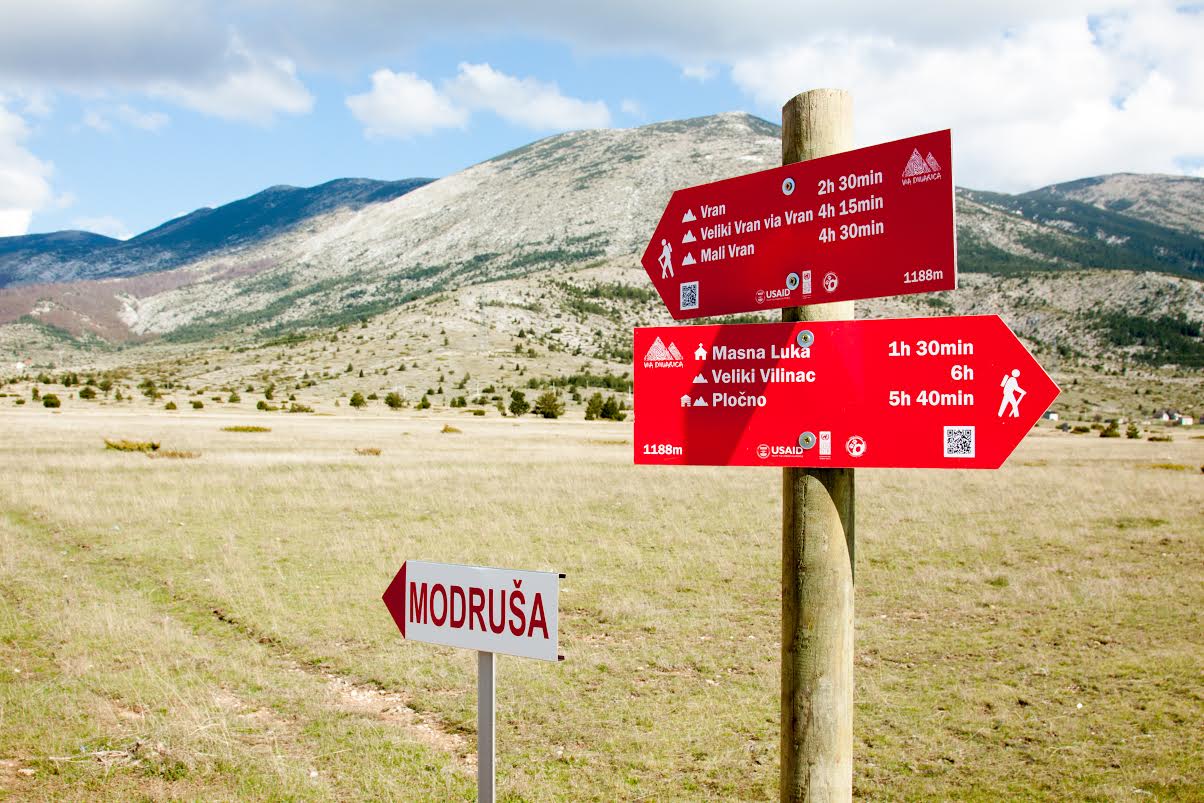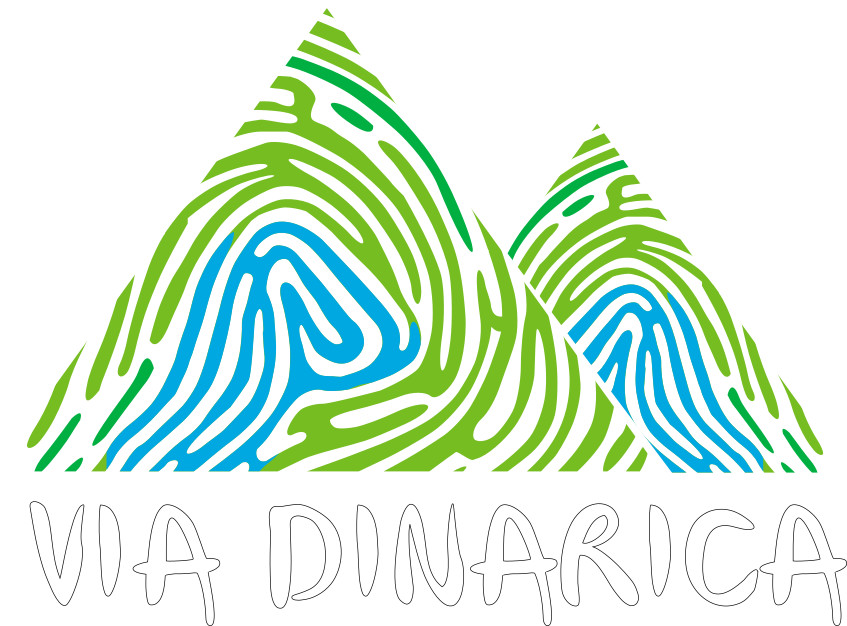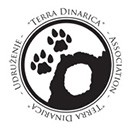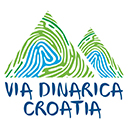The Via Dinarica is a mega trail that extends from Albania to Slovenia. The largest part of the trail slices diagonally from southeast to northwest.
The Via Dinarica trail encompasses the largest karst field on earth. Plate tectonics have created a vertebrae-like limestone chain that has aligned itself over 1,000 kilometers through the heart of the western Balkans. Its head, veering far into the skyline, is a conglomerate of jagged peaks that dominates northern Albania, northwestern Kosovo, and the Plav and Gusinje area of northeast Montenegro. The torso and heart of the Dinaric Alps cuts through northern Montenegro and most of Bosnia and Herzegovina before reaching its legs in Croatia at Dinara Mountain. The limbs reach as far west as the Montenegrin and Croatian coastlines of the Adriatic Sea and as far east as Tara National Park in Serbia. The trails tail tithers off in Slovenia at two of Europe’s greatest limestone caves at Postojnske and Skocjanske.
 Mother Nature does most of the work but there are a lot of companies and small businesses along the trail who are dedicated to providing top quality nature experiences in some of the most beautiful environments in Europe. You’d be doing yourself a great injustice by missing out on what the Via Dinarica has to offer. Before the crowds arrive, explore the majestic wilderness of the Dinaric Alps whether it be hiking, biking, rafting, or skiing adventures. As nature lovers, you’ll treasure it – we promise. As responsible travelers, you will be making a meaningful contribution to the protection and preservation of the highland cultures and what is certainly the last true wilderness frontier in Europe. Via Dinarica, it’s more than just a trail.
Mother Nature does most of the work but there are a lot of companies and small businesses along the trail who are dedicated to providing top quality nature experiences in some of the most beautiful environments in Europe. You’d be doing yourself a great injustice by missing out on what the Via Dinarica has to offer. Before the crowds arrive, explore the majestic wilderness of the Dinaric Alps whether it be hiking, biking, rafting, or skiing adventures. As nature lovers, you’ll treasure it – we promise. As responsible travelers, you will be making a meaningful contribution to the protection and preservation of the highland cultures and what is certainly the last true wilderness frontier in Europe. Via Dinarica, it’s more than just a trail.
NOTE: The White Trail is defined and all tracks can be found here. Green and Blue Trails are still under development, however, all stages that are completed will be automatically available on trail.viadinarica.com.
White Trail
This is the main trail along the entire length of the Via Dinarica that follows the natural flow of the highest peaks of the Dinaric Alps. The white trail includes all of the highest peaks in each respective country. Although there are a plethora of activities along this head trail, such as mountain biking and rafting, it’s main function is as a hiking trail.
Blue Trail
The Blue Trail veers towards the coastline and the crystal clear waters of the Adriatic Sea. The mountains may be smaller in this part but no less attractive and challenging. It includes some of the best coastal and hinterland hiking in Europe always accompanied by the fresh smell of medicinal herbs and the breeze of the Mediterranean.
Green Trail
The Green Trail is exactly that, green carpet of conifer forests that meander through some of the lower mountains of the Dinaric Alps. The Green Trail is made for two-wheeled trail blazers with hundreds of kilometers of well maintained bike trails. Hiking and walking, coupled with the rich wildlife of this eastern front, make it a great option for soft adventure.
Our portal, Via Dinarica Trail, is the place where you can find out about the main characteristics of each of the three trails and virtually travel each of the stages on the maps.
The Via Dinarica trail encompasses the largest karst field on earth. Plate tectonics have created a vertebrae-like limestone chain that has aligned itself over 1,000 kilometers through the heart of the western Balkans. Its head, veering far into the skyline, is a conglomerate of jagged peaks that dominates northern Albania, northwestern Kosovo, and the Plav and Gusinje area of northeast Montenegro. The torso and heart of the Dinaric Alps cuts through northern Montenegro and most of Bosnia and Herzegovina before reaching its legs in Croatia at Dinara Mountain. The limbs reach as far west as the Montenegrin and Croatian coastlines of the Adriatic Sea and as far east as Tara National Park in Serbia. The trails tail tithers off in Slovenia at two of Europe’s greatest limestone caves at Postojnske and Skocjanske.
 Mother Nature does most of the work but there are a lot of companies and small businesses along the trail who are dedicated to providing top quality nature experiences in some of the most beautiful environments in Europe. You’d be doing yourself a great injustice by missing out on what the Via Dinarica has to offer. Before the crowds arrive, explore the majestic wilderness of the Dinaric Alps whether it be hiking, biking, rafting, or skiing adventures. As nature lovers, you’ll treasure it – we promise. As responsible travelers, you will be making a meaningful contribution to the protection and preservation of the highland cultures and what is certainly the last true wilderness frontier in Europe. Via Dinarica, it’s more than just a trail.
Mother Nature does most of the work but there are a lot of companies and small businesses along the trail who are dedicated to providing top quality nature experiences in some of the most beautiful environments in Europe. You’d be doing yourself a great injustice by missing out on what the Via Dinarica has to offer. Before the crowds arrive, explore the majestic wilderness of the Dinaric Alps whether it be hiking, biking, rafting, or skiing adventures. As nature lovers, you’ll treasure it – we promise. As responsible travelers, you will be making a meaningful contribution to the protection and preservation of the highland cultures and what is certainly the last true wilderness frontier in Europe. Via Dinarica, it’s more than just a trail.NOTE: The White Trail is defined and all tracks can be found here. Green and Blue Trails are still under development, however, all stages that are completed will be automatically available on trail.viadinarica.com.
White Trail
This is the main trail along the entire length of the Via Dinarica that follows the natural flow of the highest peaks of the Dinaric Alps. The white trail includes all of the highest peaks in each respective country. Although there are a plethora of activities along this head trail, such as mountain biking and rafting, it’s main function is as a hiking trail.
Blue Trail
The Blue Trail veers towards the coastline and the crystal clear waters of the Adriatic Sea. The mountains may be smaller in this part but no less attractive and challenging. It includes some of the best coastal and hinterland hiking in Europe always accompanied by the fresh smell of medicinal herbs and the breeze of the Mediterranean.
Green Trail
The Green Trail is exactly that, green carpet of conifer forests that meander through some of the lower mountains of the Dinaric Alps. The Green Trail is made for two-wheeled trail blazers with hundreds of kilometers of well maintained bike trails. Hiking and walking, coupled with the rich wildlife of this eastern front, make it a great option for soft adventure.
Our portal, Via Dinarica Trail, is the place where you can find out about the main characteristics of each of the three trails and virtually travel each of the stages on the maps.




















